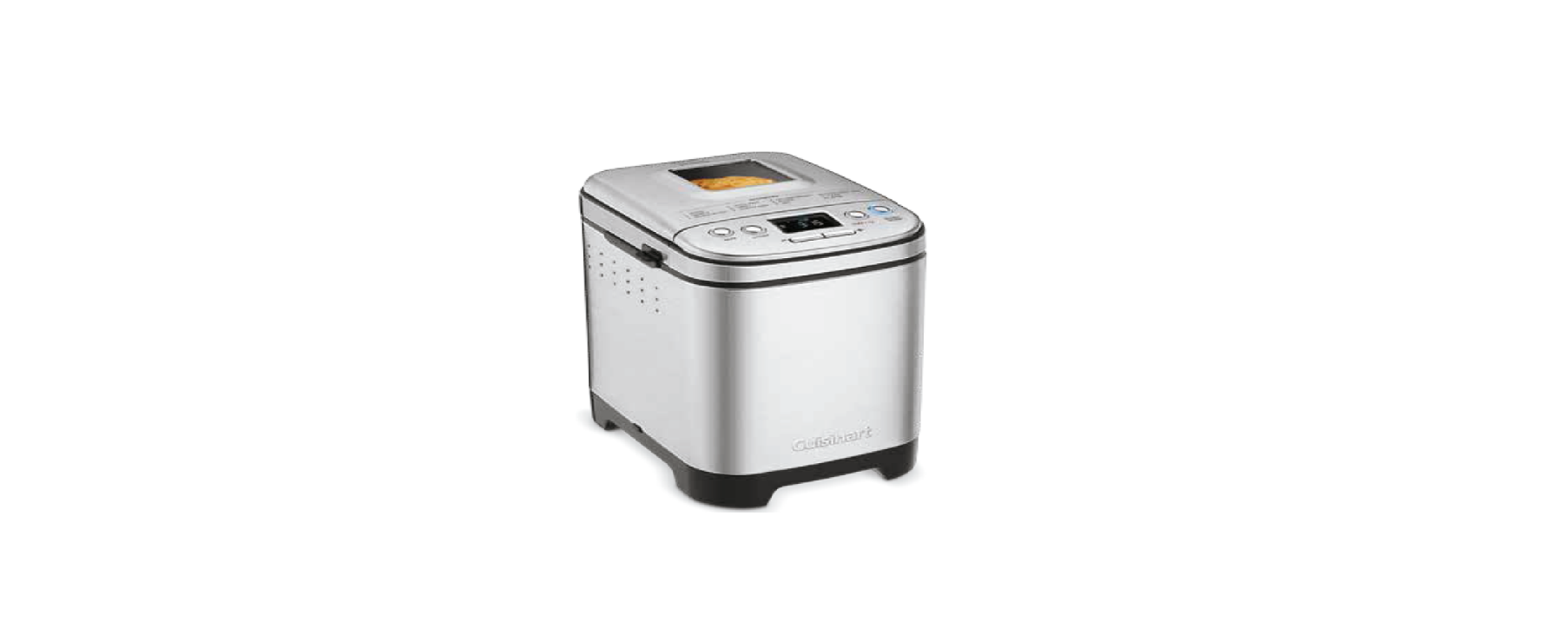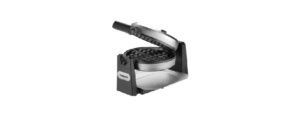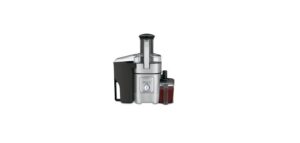Cuisinart CBK-110 Compact Bread Maker
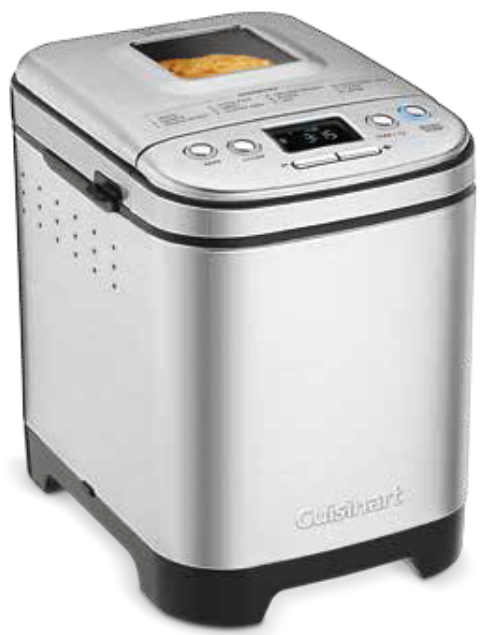
IMPORTANT SAFEGUARDS
- Do not touch hot surfaces; carry the unit with the plastic base. Always use oven mitts when handling hot material, and allow metal parts to cool before cleaning. Allow the bread maker to cool thoroughly before putting on or taking off parts.
- When the unit is not in use and before cleaning, unplug the bread maker from the wall outlet. Let the bread maker cool down completely before assembling or disassembling it.
- To protect against the risk of electric shock, do not immerse the appliance or plugs in water or other liquids.
- Close supervision is always necessary when this or any appliance is used near children or incapacitated persons.
- Do not allow anything to rest on the power cord. Do not plug in a cord where people may walk or trip on it. Unplug this bread maker from the wall outlet when not in use, before you leave for a trip, or go out for a long period of time.
- Do not operate this or any appliance with a frayed or damaged cord or plug, or after the appliance malfunctions or is dropped or has been damaged in any manner. Take the appliance to the nearest authorized service facility for examination, repair, or electric or mechanical adjustment.
- Do not let the cord dangle over the edge of a table or counter or touch hot surfaces. Do not place it on an unsteady or cloth-covered surface.
- Avoid contact with moving parts.
- 10. Do not use attachments not recommended by the manufacturer. They may cause fire, electric shock or injury or may damage the unit and void the warranty.
- Do not use it outdoors or for commercial purposes.
SPECIAL CORD SET INSTRUCTIONS
NOTICE
This appliance has a polarized plug (one blade is wider than the other). To reduce the risk of electric shock, this plug will fit in a polarized outlet only one way. If the plug does not fit fully in the outlet, reverse the plug. If it still does not fit, contact a qualified electrician. Do not modify the plug in any way.
BEFORE FIRST USE
Remove all packing material and any promotional labels or stickers from your bread maker. Be sure that all parts of your new bread maker have been unpacked before discarding any packing materials. You may want to keep the box and packing materials for use at a later date. Wipe the housing with a damp cloth to remove any dust from the warehouse or shipping. Wash the inside of the lid with a sponge or damp cloth. Wash the kneading paddle and bread pan with warm, soapy water and dry completely.
PARTS AND FEATURES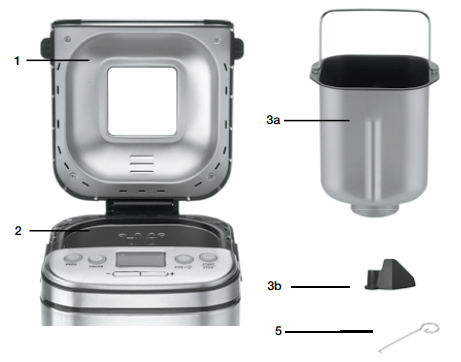
- Lid With viewing window
- Control panel with LCD display See details on next page
- Baking chamber
- a. Removable bread pan with handle Vertical loaf, nonstick coating
- b. Kneading paddle Removable, nonstick paddle
- c. The heating element (not shown)
- Power cord (not shown)
- Pan hook Helpful tool for lifting bread pan handle
CONTROL PANEL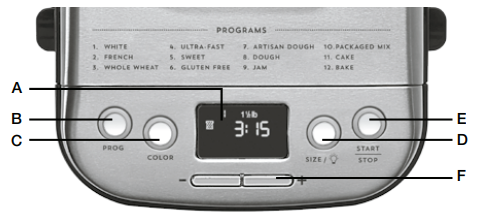
- A. LCD Display – Displays program, crust color, and loaf size selections. Also, view cycle and delay start timing.
- B. PROG Button – Select the program; refer to the program list above the display panel for options.

- C. COLOR Button – Select a light, medium, or dark crust.
- D. SIZE
- a. Select a 1-Ib., 1½-Ib. or 2-Ib. loaf.
- b. Enables internal chamber light.
- E. START/STOP Button – Starts and stops the bread-making process. Also controls the Pause function.
- F. -/+ Buttons – Adjust the time for the bake program and delay the start timer.
NOTE: Some program selections are limited to certain crust colors and loaf sizes. The LCD will display accordingly. Please see Programs and Timing on page 9 for all available combinations.
OPERATING INSTRUCTIONS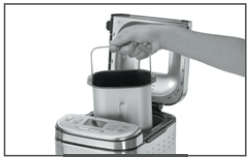
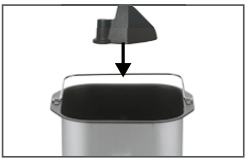
- Remove the bread pan from the baking chamber by grasping the handle, turning the pan counterclockwise, and lifting it up. It may be helpful to first lift the handle of the bread pan by using the pan hook (see Figure 1a). To properly attach the kneading paddle, insert it onto the shaft with a wide base facing down (see Figure 1b).
- Properly measure all ingredients and put them into the bread pan in the exact order they are listed. Always put the liquids in first, the dry ingredients in next, and the yeast last. Yeast should not touch wet ingredients. Please refer to the Measuring and Loading Ingredients sections (page 11) for instructions.
- Insert the bread pan back into the baking chamber, turning clockwise to lock in place.
- Close the lid and connect the power cord to a standard electrical outlet.
- Select your program by pressing the PROG button. For more information on each program, see pages 9-10.
Delay Start Timer
The Cuisinart® Compact Automatic Bread Maker can be programmed up to 13 hours in advance. For example, you can program your bread maker at 8 p.m. to finish baking at 9 a.m. Be sure to set your timer based on when you would like your bread to be complete.
- Add ingredients.
- Select the program, crust color, and loaf size.
- Set the number of hours ahead that you want the loaf to finish. By pressing the + or – buttons you can set the time for completion up to 13 hours later. Press to increase or decrease by 10-minute increments or hold the button down to scroll faster.
- Press the START/STOP button to begin the delay start countdown.
During Bread Making
The Process
- Knead – Most bread types use 2 Knead cycles. The first Knead cycle quickly mixes the main ingredients. The second Knead cycle is longer and continues the mixing process. The dough is “punched down” before the longer cycle begins, prior to removing the kneading paddle.
- Rise – Rise cycles help to ensure the perfect consistency of all yeast breads. During the Rise cycles, your bread maker will appear to be inactive. The display will show it is actually in Rise mode.
- Bake – This bread maker will consistently regulate both baking time and temperature according to the recipe you select.
- Keep Warm – This allows you to leave the finished bread in the machine to serve warm for up to 60 minutes. It also helps to keep the crust from becoming soggy if the bread is not removed from the machine immediately after baking. Some crusts will darken slightly in Keep Warm.
Options
- Light: Press and hold SIZE for 3 seconds to turn on the internal chamber light at any time. The light will automatically turn off after 30 seconds, or press and hold again to turn off.
- Pause: You can pause the process for up to 10 minutes at any time by pressing the START/STOP button while the unit is on. The time and power light will flash while the program is paused. Press START/STOP to resume the program.
- Add-ins: An audible signal of 4 sets of 5 long beeps each will sound to remind you to add any additional ingredients your recipe requires.
After Bread Making
There will be 10 beeps to signal the end of the Baking cycle; the LCD window will read 00:00. Your bread will be kept warm for 60 minutes in the keep warm cycle. There will be one long beep at the end of the Keep Warm cycle and then the unit will shut off. For optimal results, we recommend removing the loaf as soon as the Baking cycle is complete and letting it cool on a wire rack.
To remove bread from the pan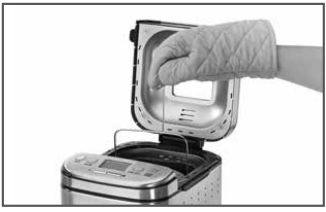
- a. Open the lid and use a pan hook to lift the bread pan handle. Using oven mitts, remove the bread pan by turning counterclockwise.
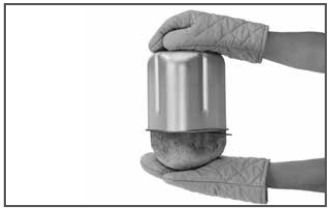
- b. Still using the oven mitts, hold the bottom of the bread pan, move the handle aside, and shake until the bread is released.
- c. For best results, allow the loaf to cool on a wire rack for 20 to 30 minutes prior to slicing.
POWER FAILURE BACKUP
This unit is equipped with a power failure backup system. In case of any disruption of the power supply, the unit will store in memory the stage of the bread-making cycle and resume once power is restored. The power backup feature can maintain memory for a power failure for up to 15 minutes.
PROGRAMS AND TIMING
For each program, there are two times listed under ADD-INS and under REMOVE PADDLE. The Displayed Time is what you will see in the countdown timer window. The Elapsed Time under ADD-INS and REMOVE PADDLE is the number of minutes that have passed since you pressed start. Elapsed Times are listed to let you know when you should return.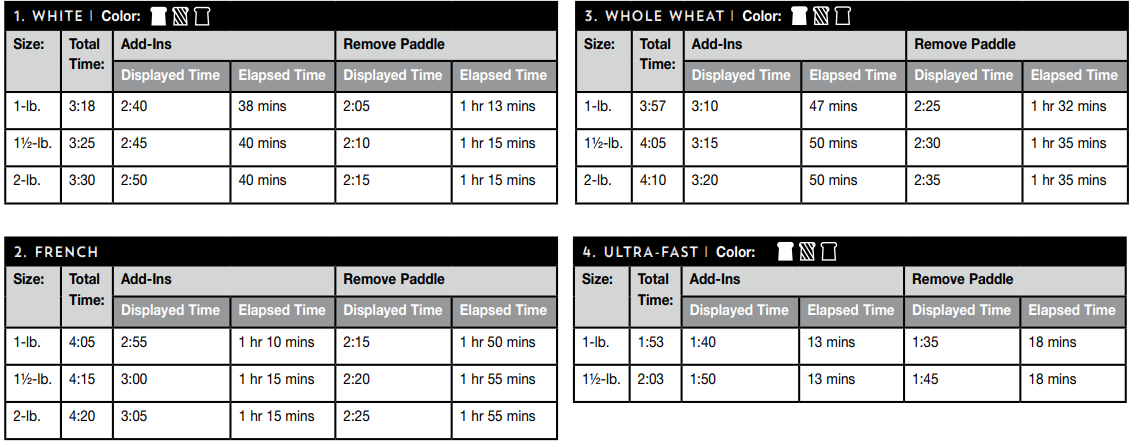
- NOTE: Removing the kneading paddle is an optional step. See page 6 for more details.
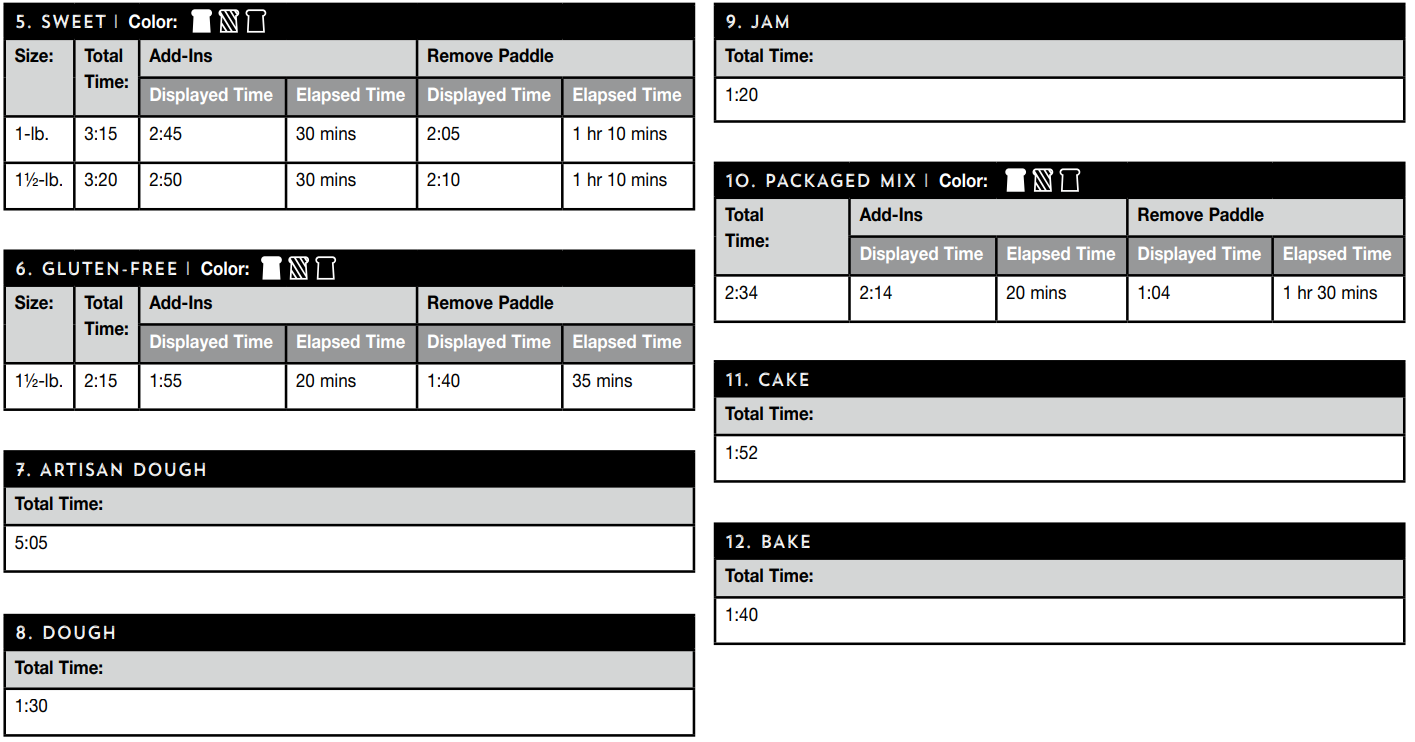
MEASURING INGREDIENTS
When measuring wet ingredients, use only liquid measuring cups with the cups/ounces marked clearly on the side. After filling the measuring cup, place it on a flat surface and view it at eye level to make sure the amount of liquid is exact. Most recipes require liquids to be at room temperature. When measuring dry ingredients, fill a dry measuring cup with a spoon and then level off the measurement with the back of a knife or a spatula to make sure the measurement is exact. Never use the cup to scoop the ingredients directly from the container (for example, flour). By scooping, you could add up to one tablespoon of extra ingredients. Do not pack down, unless otherwise noted.
LOADING INGREDIENTS INTO THE BREAD PAN
This means, in most cases: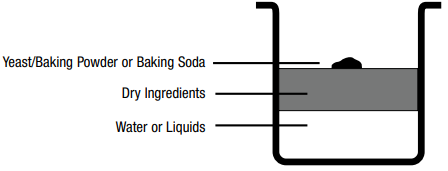
- – FIRST. liquid ingredients
- – SECOND, dry ingredients
- LAST, yeast – Yeast must be separate from wet ingredients and salt. Create a small crater in dry ingredients using your finger or a spoon, and place yeast within the crater. Make sure the yeast is fresh.
Also, make sure ALL ingredients are at room temperature unless otherwise noted (that is, between 75°F-90°F. Temperatures too cool or too warm can affect the way the bread rises and bakes. NOTE: Water should not be hot, or it will affect rising. Last, it is a good idea to start with fresh ingredients. Fresh flour and fresh yeast are critical. See the Troubleshooting section (page 17) to learn more.
MEASUREMENT/CONVERSION CHART

INGREDIENT CONVERSION CHART
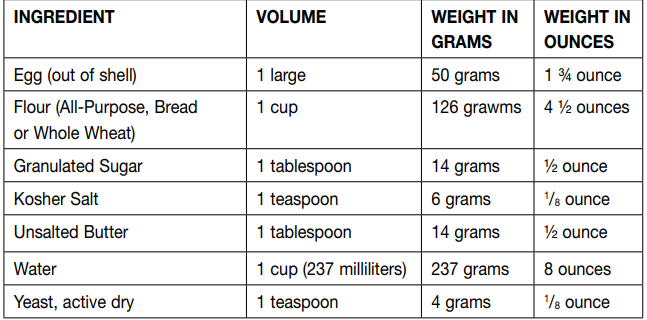
CLEANING AND CARE
Caution: Unplug the machine before cleaning. Do not put the bread maker in water or in a dishwasher. Do not use scrubbing brushes or chemical cleansers, as these will damage the machine. Use only a mild, nonabrasive cleanser to clean the outside of the bread maker.
- Bread pan and kneading paddle – Pan and kneading paddle should be hand-washed with warm water and soap. Do not use metal utensils as they will damage the nonstick surface.
- Baking chamber – Remove all bread crumbs by wiping them away with a slightly damp cloth or clean pastry brush. DO NOT bend the heating element, which is located on the inside of the bread maker.
- Lid – Wipe the inside of the lid with a sponge or damp cloth. The lid should not be immersed in water.
- Outer housing – Use only a mild, nonabrasive cleanser to clean the outside of the bread maker.
- Control panel – Wipe with a slightly damp cloth as necessary. Take care not to allow water or cleaning fluids under the buttons of the control panel.
- Maintenance – An authorized service representative should perform any other servicing.
TIPS AND HINTS
Use top-quality ingredients to make your bread-maker bread. Temperature of ingredients is important in bread-machine baking. Ideal temperatures are between 75°F-90°F. Use an instant-read thermometer to check the temperatures. Cold ingredients should be allowed to come to room temperature. Measure all ingredients accurately and have them ready before adding to bread pan. This helps to ensure that you measure each ingredient correctly, and do not find that you get down to the last (or nearly the last) ingredient and discover that it is not available in your pantry.
When measuring ingredients, use liquid measuring cups for liquids, and dry measures for dry ingredients. Stir all flours first, spoon into dry measure and level off using the flat side of a knife or spatula – do not pack down. Add ingredients to the pan in this order – liquids, melted or softened butter, salt, and sugars (including honey, molasses, syrup), herbs, flours, dried milk, vital wheat gluten (if using), and yeast. Do not allow the yeast to touch the wet ingredients. See detailed instructions on page 11.
Important
Giving the kneading paddle a light coating with a nonstick cooking spray or vegetable oil may make it easier to remove if it bakes into a loaf. On a humid day, you may need additional flour. Pay attention to the dough during the kneading process and if sticky, add flour 1 teaspoon at a time. Alternatively, if it is especially dry, you may need to add additional liquid. In most cases, the dough should be smooth and not cling to fingers when touched. Additional amounts of flour or liquid should be added 1 teaspoon at a time.
For Higher Altitudes
Flour is drier at higher altitude levels and will absorb more liquid, so use less flour in the recipe. Pay attention to the dough as it mixes and kneads – if it appears dry, add more of the same liquid used in the recipe. Doughs prepared and baked at higher altitude levels will tend to rise faster – use about ⅓ less yeast to help counteract this phenomenon.
Adding less sugar (where applicable) also helps in producing the proper dough and bread. Reduce sugar or sweetener by about ¼. Also, adding a little more salt will retard the yeast action and promote slower, more even rising. Add no more than ¼ teaspoon of additional salt. Start with one of these changes to determine the best results.
BREAD MAKER PANTRY
To be able to prepare bread quickly and easily in your Cuisinart® Compact Automatic Bread Maker, we suggest keeping some basics on hand. Depending on the types of breads you and your family prefer, you may also want to have some of the other items readily available.
Storing Ingredients
- White Flours (all-purpose, bread and cake): These should be stored in a dark, cool place for up to 1 year (but best to go by the use-by date on the bag). These can also be put in the freezer for a year as well, but be sure to wrap them well so they do not pick up any flavors or odors from the freezer.
- Whole-grain and most Gluten-Free flour: In a cool, dark place for up to 3 months, or in the freezer for up to 6 months.
- Nut Flours: These are very prone to spoiling, so store them in the refrigerator for up to 3 months or in the freezer for up to 6 months.
- Starches and Gums: More stable than flour, these can be stored in a cool, dark place for at least a year.
- Yeast: Always store in the refrigerator and check the expiration date prior to using.
GLUTEN-FREE INGREDIENTS
- Almond Flour Be sure to read the label because some baking powders use starches to keep the compound dry, which may affect those with gluten allergies.
- Baking Soda – Baking soda is a chemical leavening that requires an acidic ingredient to activate. Examples include brown sugar, buttermilk, yogurt, etc. Not only does baking soda provide lift to your baked product, but it also improves browning.
- Buckwheat Flour – Buckwheat is not actually wheat at all. Buckwheat flour has a high protein content and a pleasant nutty flavor.
- Cornstarch – Cornstarch is a way to add structure and stability to a gluten-free bread that is otherwise provided by gluten. Be sure not to go overboard, or your finished bread will have a very starchy and unpleasant flavor.
- Flax Seeds (ground) – When ground, flax seeds are even more nutritious and act as a binder to produce a stable structure in baked goods.
TROUBLESHOOTING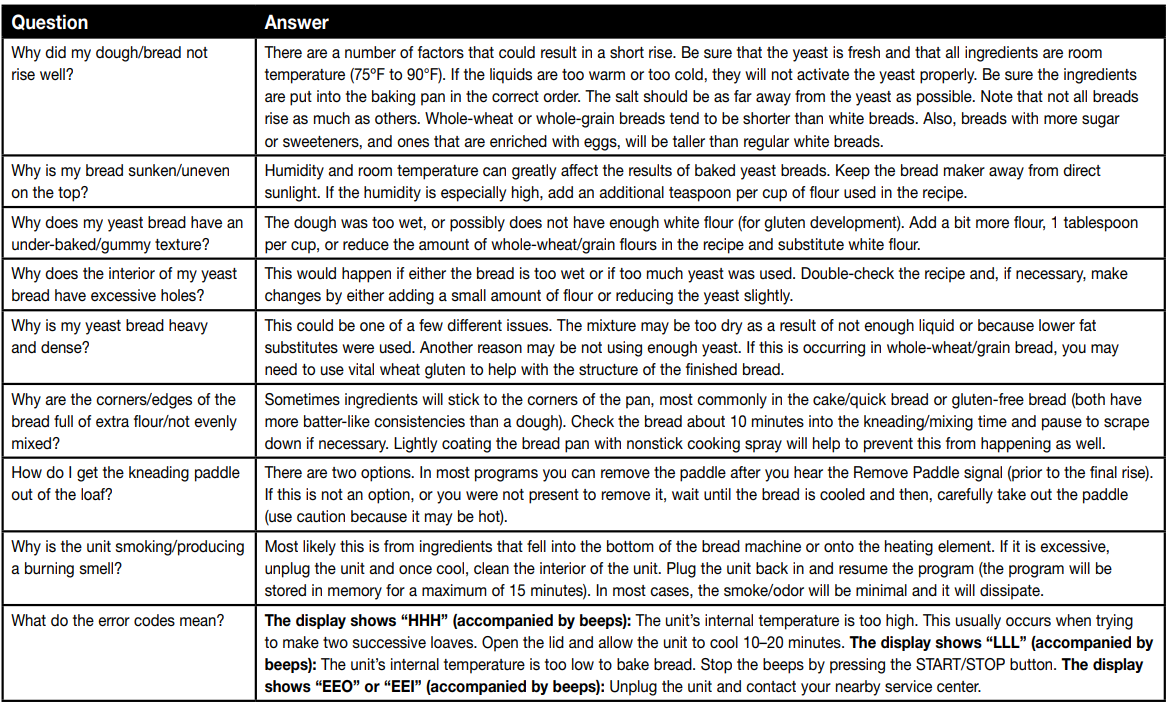
WARRANTY
This warranty is available to consumers only. You are a consumer if you own a Cuisinart® Compact Automatic Bread Maker that was purchased at retail for personal, family, or household use. Except as otherwise required under applicable law, this warranty is not available to retailers or other commercial purchasers or owners.
We warrant that your Cuisinart® Compact Automatic Bread Maker will be free of defects in materials and workmanship under normal home use for 3 years from the date of original purchase. We recommend that you visit our website, www.cuisinart.com for a fast, efficient way to complete your product registration. However, product registration does not eliminate the need for the consumer to maintain the original proof of purchase in order to obtain the warranty benefits. In the event that you do not have proof of purchase date, the purchase date for purposes of this warranty will be the date of manufacture.
CALIFORNIA RESIDENTS ONLY
California law provides that for In-Warranty Service, California residents have the option of returning a nonconforming product
- to the store where it was purchased or
- to another retail store that sells Cuisinart products of the same type.
The retail store shall then, according to its preference, either repair the product, refer the consumer to an independent repair facility, replace the product, or refund the purchase price less the amount directly attributable to the consumer’s prior usage of the product.
U.S. and Canada Only
California residents may also, according to their preference, return nonconforming products directly to Cuisinart for repair or, if necessary, replacement by calling our Consumer Service Center toll-free at 800-726-0190. Cuisinart will be responsible for the cost of the repair, replacement, shipping, and handling of such nonconforming products under warranty.
BEFORE RETURNING
To obtain warranty service, please call our Consumer Service Center toll-free at 1-800-726-0190 or write to Cuisinart, 7475 North Glen Harbor Blvd., Glendale, AZ 85307. To facilitate the speed and accuracy of your return, enclose $10.00 for shipping and handling. (California residents need only supply proof of purchase and should call 1-800-726-0190 for shipping instructions.)

